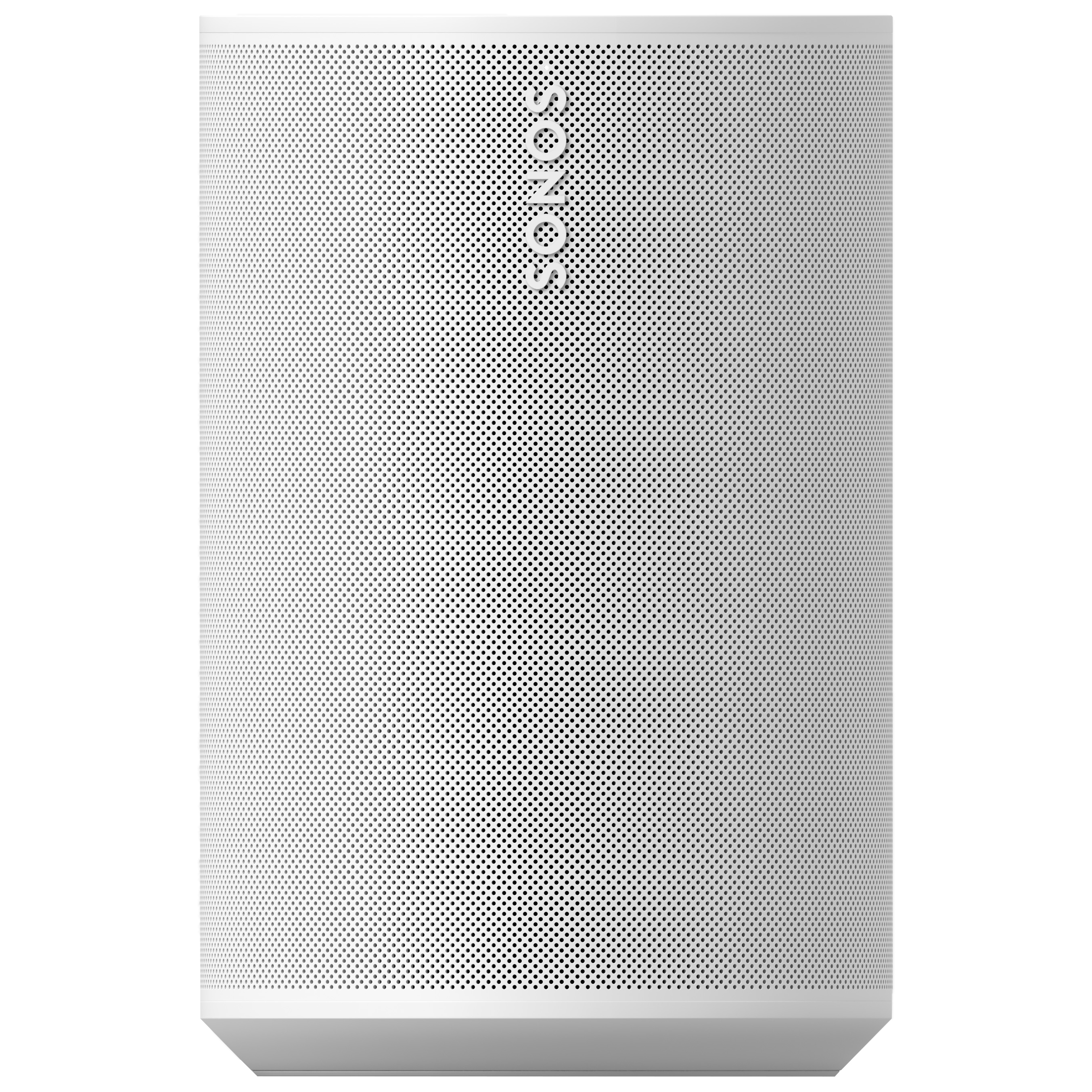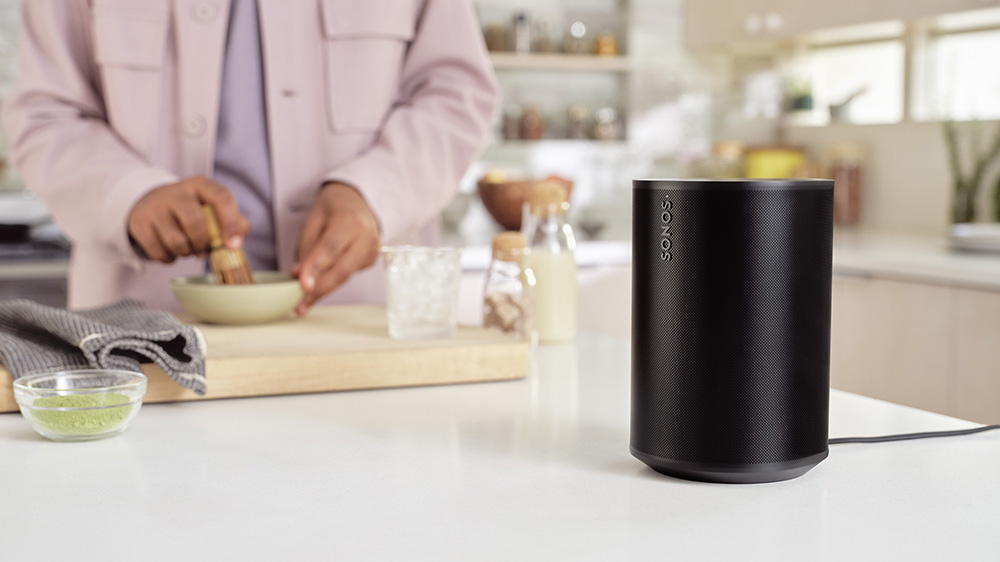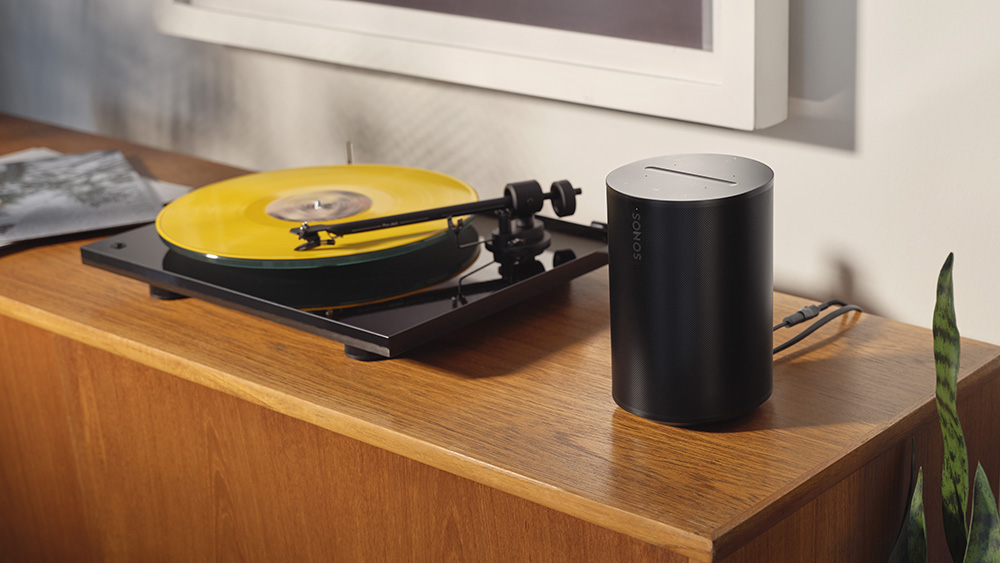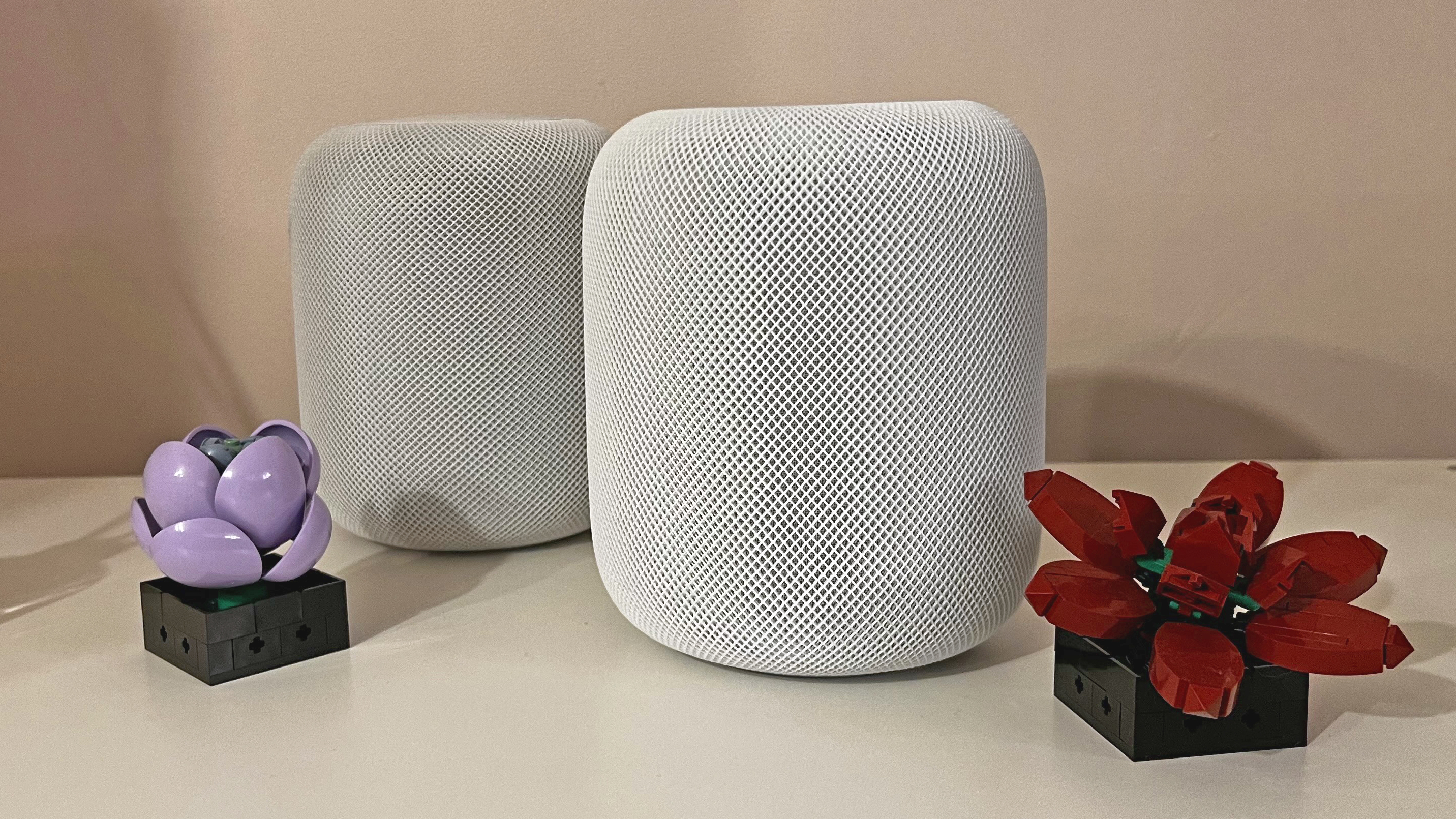Sonos Era 100 vs Apple HomePod 2: which Wi-Fi speaker is right for you?
Two new smart speakers with a focus on audio quality, but which should you pick? We break it all down

Dimensions: 7.18 x 4.72 x 5.14 in (182.5 x 120 x 130.5 mm)
Weight: 4.44 lb (2.02 kg)
Connectivity: Wi-Fi, Bluetooth 5.0, AirPlay 2
Line-in option: Yes, with adapter
Sonos describes the Sonos Era 100 as its "next-generation smart speaker". It offers rich bass, stereo sound, voice control, Wi-Fi and Bluetooth audio streaming, and you can connect wired sources with an aux-in adapter. Its design is compact and sound is much improved over the Sonos One it replaces. Alexa and Sonos Voice Control handle the smart stuff.
Pros
- Wide sound with good bass
- Cheaper than HomePod 2
- Bluetooth audio, plus 3.5mm line-in via adapter
Cons
- No Dolby Atmos support
- Stereo effect isn't strong
- Price rise over Sonos One

Dimensions: 6.6 X 5.6 in (168 X 142 mm)
Weight: 5.16lb (2.3 kg)
Connectivity: Wi-Fi, Bluetooth 5.0, AirPlay 2
Line-in option: No
The Apple HomePod 2 offers stunningly clear, detailed and well-balanced sound from a fairly compact package. But it requires you to run an extremely Apple-heavy household, due to its lack of Bluetooth audio, line-in support, or any streaming option other than AirPlay. Siri also simply isn't as flexible as Alexa when it comes to the smart side of things.
Pros
- Excellent clarity and detail
- Dolby Atmos support
- Smart home hub
Cons
- No Bluetooth or aux-in
- Siri just isn't that useful
- More expensive
Sonos has shaken up the smart speaker space with the launch of the Sonos Era 100. An upgrade on the fantastic Sonos One speaker, the Sonos Era 100 boasts a full soundstage and crisp, clear audio. But how does it compare with some of the best smart speakers already on the market?
The Sonos Era 100 offers quality audio, but it isn't cheap. This means it doesn't make much sense to compare it to some of our favorite smaller wireless speakers, like the Apple HomePod Mini or Amazon Echo Dot. But given its size, price and fantastic sound it's a solid rival for Apple's latest full-size smart speaker, the Apple HomePod 2.
At first glance, the Sonos Era 100 and Apple HomePod 2 seem incredibly similar with compact designs, a host of features and great-sounding audio. But take a closer look and there are some key differences here that will be dealbreakers depending on your current set-up and preferences. Let's get into it to find out which smart speaker is best for you, the Sonos Era 100 vs Apple HomePod 2?

Sonos Era 100 vs Apple HomePod 2: Price and availability
The Apple HomePod 2 was released on February 3, 2023, and it costs $299 / £299 / AU$479. The Sonos Era 100 is released on March 28, 2023. It costs $249 / £249 / AU$399. The latter could benefit from any currently available Sonos promo codes if you check them out.
The Apple HomePod 2 is a little more expensive, but their price is similar overall, especially when compared to rivals. This is hardly surprising as Apple and Sonos are two high-performing brands that are never afraid to go premium.
As we'll learn further down this guide, these prices are justified. Both speakers sound fantastic and offer a range of features. But that's only true to a point. Those with specific preferences, like Android phone users, won't get their money's worth from the Apple HomePod 2 as it's very much geared towards Apple users.
However, comparing both speakers to the wider market, their price tags aren't all that out there. From our best smart speakers guide, there's the Bose Smart Speaker 500, which is more expensive at $399 / £399 / AU$599, and the Denon Home 150 that's a little cheaper at $249 / £219 / AU$340.
Sign up for breaking news, reviews, opinion, top tech deals, and more.

Sonos Era 100 vs Apple HomePod 2: Features
There are a few key feature differences that set the Sonos Era 100 and Apple HomePod 2 apart. The first is that the Sonos Era 100 has an aux-in input, via an adapter. This means you can connect external audio sources, such as one of the best turntables, to it and play your music. The Apple HomePod 2 doesn't have any inputs.
Secondly, the Sonos Era 100 supports Bluetooth audio. By simply pressing a button you can stream music to your Era 100 from any device. The Apple HomePod 2 has Bluetooth tech in it, but that's only used for smart home control – not audio. Instead, it's a Wi-Fi-connected smart speaker based on Apple's Siri assistant, with the ability to also send music to it over Apple's AirPlay 2. The HomePod 2 is simply much less flexible – if anyone in your family/household has an Android smartphone, the Sonos makes more sense.
When it comes to smart assistants, the support for Alexa on the Sonos makes it more useful overall than Siri on the HomePod 2, which we bemoaned for simply not being smart enough (still) in our HomePod 2 review. If you want more privacy, you can use Sonos' own Voice Control system, which just works music, and all processing is done on-device.
The HomePod 2 does have one big feature advantage over the Sonos, though: it works as a smart home hub. It can trigger Thread/Matter devices, or HomeKit devices – either running automations, or enabling you to control to them remotely even if they're not internet-connected.

Sonos Era 100 vs Apple HomePod 2: Sound quality
We've only had a hands-on testing session with the Sonos Era 100 to date, but we can confirm it sounds great. In our hands-on review we said that the Era 100 has an impressively big sound with improved bass over the Sonos One, which was the only real weakness of that speaker. What's more, you can pair it with the Sonos Sub Mini for even more bass.
Does the Sonos Era 100 fill a room? Sort of. We found the expansiveness of the audio to be really impressive, and it certainly seemed bigger than one speaker. But we didn't feel like we got stereo separation, which is hardly surprising from a speaker of this size.
It's also relevant to note here that there's a new type of TruePlay tuning coming with the Sonos Era 100, which Sonos is calling this 'Quick Tuning', and it's still done from the Sonos app, but unlike regular TruePlay tuning, it can be done from Android as well as iOS. A sound is played, and the mics in the Era 100 listen to the sound, and tune for the room accordingly.
The Apple HomePod 2 also offers a fantastic audio experience. In our Apple HomePod 2 review we wrote: "The audio quality is fantastic for the price. The high-end pops and hits with great clarity, the mid-range is fulsome and expressive, and bass is weighty yet controlled."
However, the key difference between the two speakers is that the Apple HomePod 2 offers Dolby Atmos, but does it deliver on its promise? Yes and no. We found it depended on our positioning. The HomePod 2 is able to steer sounds around in the mix in a way that's totally different to what you get from a stereo setup, and more than the original HomePod can. However, we did note that Dolby Atmos music doesn't sound as natural as regular music. "Ironically, adding more spreadable sound makes the sound feel boxier," we wrote in our review. "A little more clipped, a little harder."
Where the Apple HomePod 2 really stood out for us sound-wise was when we paired two of them together. They used Dolby Atmos to do very clever and impressive things with sound positioning, and the overall speaker balance was excellent.
The Sonos Era 100 can also be paired into stereo, but we haven't been able to try this out yet.

Sonos Era 100 vs Apple HomePod 2: Design
Design-wise these speakers aren't too far apart. The Sonos Era 100 has a cylindrical design with defined edges, whereas the the Apple HomePod 2 is more rounded and a little shorter and wider.
Their similarities aren't surprising considering they're both made to fit in compact spaces, whether you want to place them on bookshelves or have them not take up too much room on a kitchen countertop.
There are black and white versions of both and controls on the top. Although with the Apple HomePod 2 you also get a swirling, colorful "screen", which shows you when music is playing and Siri is active.
Sonos Era 100 vs Apple HomePod 2: Conclusion
The Apple HomePod 2 sounds fantastic, especially if you have the budget to have two playing in stereo. But it's the additional features and flexibility that are packed into the Sonos Era 100 that mean it will probably be a better proposition in our opinion, especially if you want to listen to external audio sources, connect to the device via Bluetooth and you're sick of Siri.
The best smart speaker is mostly going to be down to personal preference, and in particular your relationship with Apple. If you want to make the most of Apple Music including lossless support and Dolby Atmos, the Apple HomePod 2 may make more sense.
Anyone else is likely to be happier with the Sonos Era 100, especially if they're already bought into the Sonos ecosystem. With that in mind, we also recommend you check out the Era 100's big brother, the Sonos Era 300 in our Sonos Era 300 vs Sonos Era 100 guide.

Becca is a contributor to TechRadar, a freelance journalist and author. She’s been writing about consumer tech and popular science for more than ten years, covering all kinds of topics, including why robots have eyes and whether we’ll experience the overview effect one day. She’s particularly interested in VR/AR, wearables, digital health, space tech and chatting to experts and academics about the future. She’s contributed to TechRadar, T3, Wired, New Scientist, The Guardian, Inverse and many more. Her first book, Screen Time, came out in January 2021 with Bonnier Books. She loves science-fiction, brutalist architecture, and spending too much time floating through space in virtual reality.